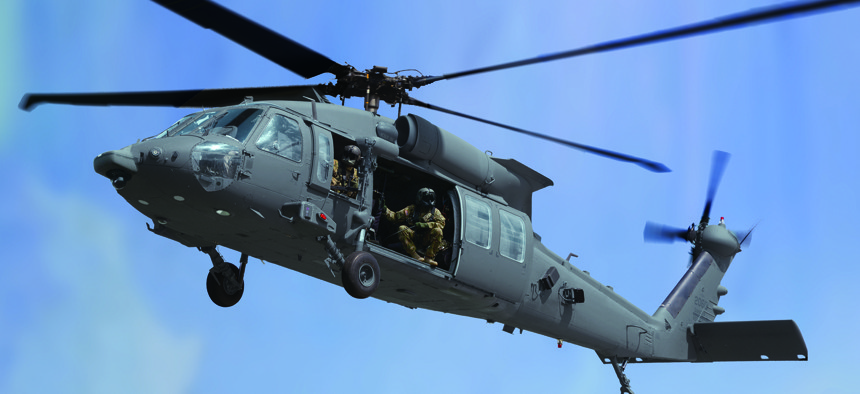
A concept of Sikorsky's new HH-60U, which it is pitching to replace 1960s-era Air Force Hueys. Lockheed Martin
Sikorsky Pitches Area 51 Security Helicopters to Guard ICBMs
Company executives say it’s the most efficient way for the Air Force to replace its half-century-old Hueys.
How can the U.S. Air Force finally end its decade-plus quest to replace the 1960s-era Huey helicopters that guard its midwestern ICBM fields? Sikorsky has a new pitch: buy more of the Black Hawk variant that supports Area 51.
Formally designated the HH-60U, the helicopter already flies in the Air Force’s “Ghost Squadron,” a unit that supports missions at the Nevada Test and Training Range and the top-secret Air Force testing base near Groom Lake known as Area 51.
“For us, obviously, that makes it a low-risk approach; the fact that they have three of these and the fact that we’ve already integrated these various components into the aircraft,” Sam Mehta, president of Sikorsky defense system and services, said in an interview.
Boeing, Leonardo, Bell, and Airbus are among the other companies likely to compete for a contract to build 84 helicopters. In addition to guarding missile fields, some of the new helicopters would be staged in Washington to evacuate lawmakers and key government officials if catastrophe struck.
The Air Force has been trying to replace the UH-1 Huey for more than a decade. In 2011, it actually moved to buy Black Hawks for the nuclear-security mission, but eventually shelved that plan in favor of competition. The latest delay came last month, when service officials said they would revise a request for proposals that some companies said would have kept them from bidding.
While Sikorsky executives did not detail how they might modify the Black Hawk — one of the most widely used military helicopters in the world — for the new competition, they would likely install a hoist, infrared camera, gun mounts, and a self-defense system to ward off hostile fire. Overall, the HH-60Us would share 85 percent of its parts with the HH-60Ws the Air Force is buying to replace its Pave Hawk combat-search-and-rescue helicopters, said David Morgan, manager of U.S. Air Force business development at Sikorsky.
That commonality with another ongoing helicopter purchase would reduce the price tag for the HH-60U, and allow the company to deliver the new aircraft as soon as 2018.
An Army UH-60M, a standard version of the Black Hawk, costs about $14.5 million. Sikorsky has built more than 1,000 of that version.
Mehta also said that since the Air Force already has Black Hawks — not to mention the thousands more in the Army and Navy — it could save money when upgrading and maintaining new aircraft and reduce pilot training costs.
“The idea there is to propose something which will allow the customer to leverage all the infrastructure investments that have already been made in the Hawk model,” he said. “And probably most importantly — at a time when one of the Air Force’s No. 1 challenges is pilot training — it would allow Black Hawk-trained pilots to continue to fly Black Hawks, so you wouldn’t have the disruption, the cost, the delay and the risk associated with getting experienced pilots to be able to switch into a new model type.”




